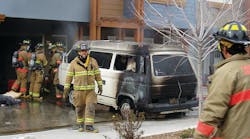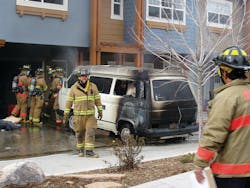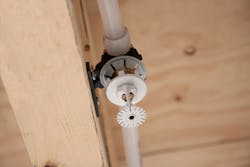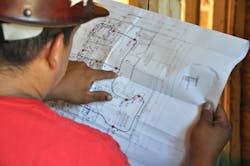A Durango homeowner watched in disbelief as flames from an overheated van threatened to engulf her garage and destroy the attached townhome. But shock turned to relief when the home’s fire sprinklers had activated. “Damage to the home was limited to the garage, thanks in large part to the fire sprinklers, which controlled the flames before they could build deadly heat and smoke, typical of a gasoline fire,” said Durango Fire Marshal Tom Kaufman.
It is instances like this that are proof positive that residential fire sprinkler installation is the smart — and safe — thing to do. Adding fire sprinklers into a business portfolio of solutions can differentiate you from your competition. By developing a thorough knowledge of the requirements and benefits of residential fire sprinklers, you can become a trusted resource for builders, developers, homeowners, and even city managers.
“It’s a five-win situation for everyone involved, which means you can grow your business while providing a benefit for all the stakeholders,” says Eric Skare, product manager, Fire Safety Systems, Uponor.
Installation of residential sprinklers has continued to grow each year since 2010, but have not yet reached the level of 2006-07. “Most residential sprinklers continue to be installed in multi-family housing and hotels, but the one- and two-family residential market will continue to grow,” said Steve Muncy, CAE, president of the American Fire Sprinkler Association.
According to Skare, the most visible trend affecting the residential fire sprinkler market is the growing use of trade-ups. These are being offered if entire new developments, or subdivisions, of single-family homes are protected by fire sprinkler systems.
“The fire service recognizes the exceptional level of protection offered by residential fire sprinklers and is starting to allow a reduction in some of the infrastructure requirements — such as hydrant spacing, smaller water mains, and a reduction in the spacing between homes — when fire sprinkler systems are installed,” said Skare.
Codes & Standards
It’s no secret that engineered wood technology has become a popular choice for structural wood joists in new construction of family homes throughout the United States.
“With this new trend comes new regulatory standards, and new opportunities for fire sprinkler system applications,” said Mark Knurek, regional market manager, BlazeMaster Fire Sprinkler Systems.
As more cities across the country pass fire sprinkler regulation in new residential construction, demand has increased amongst contractors for cost-effective and easy-to-install solutions in order to meet code and keep families safe.
Building-code requirements for fire sprinkler systems in new single-family homes continue to increase. Because the requirement for fire sprinklers has been in the International Residential Code (IRC) since the 2009 edition, more states are starting to adopt these requirements. In many areas, the language in the model code is being modified, and different phase-in approaches are being used, such as starting only with larger homes or basing requirements on proximity to fire stations.
“It appears that as states adopt recent versions of the IRC, the requirement for fire sprinklers in townhouses has progressed with much less controversy and opposition than in single-family homes,” said Uponor’s Skare.
According to Muncy, although the requirement that one- and two-family homes must have residential sprinklers remains in the International Residential Code, homebuilders have had some success in getting states or municipalities to remove the requirement. They have done this by specifically prohibiting cities from adopting any codes that require residential sprinklers or by delaying implementation of the current building code.
“As time goes on, I believe they will have less success in delaying the requirement. Cities and states that ignore the established building codes may face insurance and liability issues,” said Muncy. Two states require residential sprinklers in all new homes — California and Maryland. “As the effectiveness of mandating sprinklers in all new homes in these states is further established, it will be more difficult to get states to ‘opt out’ of the sprinkler requirements. Studies by the Fire Protection Research Foundation have shown sprinklers do not drive customers away by pricing them out of the market and the cost of installations in new homes is minimal as a percentage of the cost of the home,” said Muncy.
FM Approvals, one of the foremost testing and approval laboratories in the fire protection industry, has approved CPVC pipe and fittings as chemically compatible with internal coatings for steel pipe. An approval from FM eliminates any compatibility doubts for contractors, specifiers, engineers and AHJs. Recent changes in NFPA Standards 13 and 13R now require that internally coated steel piping be evaluated for chemical compatibility with non-metallic piping by a testing laboratory.
“That requirement makes this FM approval even more significant,” said Knurek.
Sprinkler Training
When lives and property are on the line, proper fire sprinkler installation is critical, and training is very important. While the basics of installation have been the same for quite some time, the industry has seen—and continues to see—a lot of changes.
“Installation standards continue to change. Piping has changed. The growth in the number of styles and applications of sprinkler devices is huge,” said Muncy.
AFSA specializes in developing training materials for apprenticeship programs for sprinkler fitters, for layout technicians and inspectors, and it offers paper-based courses with testing, online training and classroom training. A majority of seminars at the annual AFSA Convention and Exhibition are focused on installation techniques, proper implementation based on NFPA standards, and industry changes.
Since fire sprinkler systems are, at least in single-family homes, life-safety systems, training on the proper installation and understanding the requirements cannot be overstated.
“Uponor has a two-level training program, designed to fully educate installers on the requirements of NFPA 13D, as well as hands-on training to develop efficient and proper installation practices and techniques,” said Skare. “We teach our installers why Uponor’s NICET certified designers utilize specific system designs, the hydraulic benefits of looped systems, and the benefits of multipurpose systems in single-family homes. Then we work with them on the jobsite to put those classroom discussions into practice.”
Materials Choice
Uponor Fire Safety Design Services recently obtained a Fire Protection Contractor Design License for standalone fire sprinkler systems in the state of Minnesota, allowing the team to design both standalone as well as multipurpose plumbing and fire sprinkler systems for residential structures. This is in response to changes to the National Fire Protection Association (NFPA) 13D Standard for the Installation of Sprinkler Systems in One- and Two-Family Dwellings and Manufactured Homes, which now includes provisions for PEX in standalone fire sprinkler system designs. Since 2000, Uponor has offered a multipurpose plumbing and fire sprinkler system called AquaSAFE that combines the fire sprinkler system with a home’s cold-water potable plumbing system.
When choosing a CPVC fire sprinkler systems provider, it’s important to consider the support behind the product. With CPVC still a new product within the industry, proper training on the installation process — including solvent-welding — can be the difference between a successful project and a system failure later. Additionally, it’s important to have the proper tools in place to ensure the chemical compatibility of CPVC systems with other products that may be used on an installation job.
“Lubrizol, for example, puts its full support behind BlazeMaster systems, offering unmatched R&D, on-site training and its unique FBC System Compatible Program to ensure chemical compatibility with other construction materials it may come in contact with,” said Knurek.
Making the Move
According to Muncy, installation of fire sprinklers is a unique trade. It requires knowledge and understanding of the applicable NFPA standards, as well as building code requirements specific to fire protection. In addition, there are different codes and standards that apply to installations for commercial and residential markets.
“A decision to enter the sprinkler market should not be taken lightly. It is different than plumbing, HVAC and mechanical; different standards apply and different requirements apply,” Muncy pointed out. “However, provided that sprinkler experience and knowledge can be acquired, a company can leverage their other assets to enable sprinkler installations to be very profitable.”





